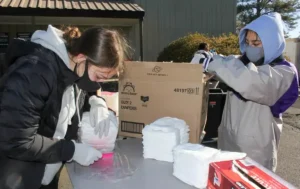Understanding Medicaid and Its Diaper Programs
Medicaid is a joint federal and state initiative designed to provide health coverage for low-income individuals, families, children, seniors, and people with disabilities. While it covers a wide range of medical services and supplies, diapers and incontinence products fall into a unique category. For healthy infants, diapers are considered a daily living expense, similar to food or clothing, and are therefore not covered. However, when diapers are medically necessary such as for a child with a developmental delay, an adult with a spinal cord injury, or a senior with dementia Medicaid may provide coverage.
Medicaid Diaper Programs specifically refer to this type of assistance. The coverage applies to both children and adults who require diapers due to medical conditions. Typically, families must demonstrate medical necessity, supported by a physician’s diagnosis, to receive coverage. For example, a child older than 3 or 4 years who is not toilet-trained due to autism, cerebral palsy, or another developmental condition may qualify. Similarly, adults with multiple sclerosis, Parkinson’s disease, or traumatic brain injuries may also receive assistance.
Does Medicaid Cover Diapers?
The simple answer is yes, but coverage comes with several conditions and limitations. Medicaid does not automatically provide diapers for every enrollee. Instead, eligibility is determined by age, medical necessity, and state-specific regulations. Generally, Medicaid does not cover diapers for healthy babies, since they are expected to be a standard household expense. Children over the age of 3 or 4, however, may be eligible if they have a qualifying medical condition. A physician must document this diagnosis and confirm that diapers are required as part of the patient’s care plan.
Coverage for adults is typically broader, but still subject to restrictions. For instance, seniors who are enrolled in Medicaid’s long-term care programs often qualify for incontinence supplies if they have conditions such as Alzheimer’s disease, dementia, or Parkinson’s. Adults under 65 may also qualify if they are incontinent due to medical issues like spinal cord injuries, diabetes complications, or neurological conditions. Even with approval, Medicaid may limit the number of diapers provided each month, with many states offering between 180 and 240 diapers as the standard monthly allowance.
Eligibility Requirements for Medicaid Diaper Programs
To receive coverage, families and individuals must first be eligible for Medicaid itself. This typically requires meeting income thresholds set at the federal and state levels, as well as being a U.S. citizen or lawful resident. Once general eligibility is established, the next step involves securing medical documentation. A doctor must evaluate the individual, confirm the diagnosis causing incontinence, and often provide a Certificate of Medical Necessity (CMN).
Each state may also impose additional requirements. For example, some states only cover diapers for children older than 3 years, while others may allow exceptions for younger children with severe medical conditions. States also differ in terms of which brands and product types are covered, as well as how many diapers can be distributed per month. This variability underscores the importance of checking with your state’s Medicaid office to fully understand what is available in your area.
Medicaid Diaper Coverage by Age Group
Coverage under Medicaid tends to look different depending on the age and medical condition of the recipient. For infants and toddlers, Medicaid rarely covers diapers unless there is a significant underlying health condition, such as congenital neurological disorders. For children between the ages of 3 and 18, coverage becomes more common, particularly for those diagnosed with autism, cerebral palsy, or other developmental delays that affect toilet training.
Adults aged 18 to 64 often receive coverage if they suffer from incontinence related to chronic or traumatic health conditions. Seniors, especially those in long-term care facilities or who qualify for in-home support services under Medicaid, are frequently approved for diaper assistance. Conditions such as dementia, Alzheimer’s disease, and Parkinson’s are among the most common reasons seniors receive Medicaid-funded incontinence supplies.
How to Apply for Medicaid Diaper Coverage
The process of applying for diaper coverage through Medicaid generally follows several steps. First, families must confirm their Medicaid eligibility, either by contacting their state’s Medicaid office or by reviewing online resources. Next, it is essential to obtain medical documentation. This usually involves visiting a physician who can evaluate the condition and issue a prescription or Certificate of Medical Necessity.
Once documentation is in hand, families must work with a Medicaid-approved supplier. Medicaid requires that diapers be ordered through approved medical supply companies rather than purchased directly from retail stores. These suppliers not only provide the products but also assist with insurance paperwork and often arrange for monthly home deliveries. The final step is submitting the necessary paperwork, which may include the physician’s prescription, Medicaid identification information, and any state-specific forms. Once approved, families typically receive a set monthly supply of diapers, which can be reordered regularly through the supplier.
Medicaid-Approved Diaper Suppliers
A number of national suppliers work directly with Medicaid to provide incontinence products to eligible individuals. Companies such as Aeroflow Urology, ActivStyle, 180 Medical, and Shield HealthCare are among the most commonly used providers. In addition to delivering supplies, these companies often simplify the administrative burden for families by managing insurance documentation, setting up monthly delivery schedules, and sending reminders when it is time to reorder.
Additional Resources Beyond Medicaid
Not every family qualifies for Medicaid, and even for those who do, the number of diapers provided each month may not fully meet the need. Fortunately, there are additional resources available to help. Programs like WIC (Women, Infants, and Children) and SNAP (Supplemental Nutrition Assistance Program) do not cover diapers directly, but they free up household funds by covering food and other essentials. The National Diaper Bank Network distributes free diapers through a network of nonprofit organizations across the country. Local charities, churches, and community-based programs may also provide diaper assistance or financial support for families in crisis.
Frequently Asked Questions
Many families have questions when navigating Medicaid’s diaper programs. One of the most common is whether Medicaid covers diapers for infants. In most cases, it does not, unless the infant has a medical condition requiring them. Another frequent question concerns brand choice. Typically, Medicaid restricts coverage to approved brands provided through contracted suppliers, meaning families cannot choose freely among all diaper options available on the market. The number of diapers supplied each month also varies by state, though the range is usually between 180 and 240. Finally, families often ask about adult diapers. These are covered for individuals with valid medical diagnoses, though again, documentation is required.
Conclusion
The financial and emotional toll of managing incontinence can be heavy for families caring for children with disabilities, adults with chronic illnesses, or seniors needing long-term care. Medicaid Diaper Programs serve as a crucial resource, helping reduce costs while ensuring that individuals receive the supplies they need for health, comfort, and dignity. To make the most of these benefits, families must take time to understand their state’s policies, gather the appropriate medical documentation, and work with approved suppliers.
Even with Medicaid assistance, additional resources such as diaper banks, nonprofit programs, and community charities can help fill the gap. By combining state-supported benefits with local support networks, caregivers can better manage both the financial and practical challenges of incontinence care. Ultimately, these programs are not just about providing diapers they are about preserving quality of life, supporting caregivers, and ensuring dignity for people of all ages who live with medical conditions that require incontinence supplies.

